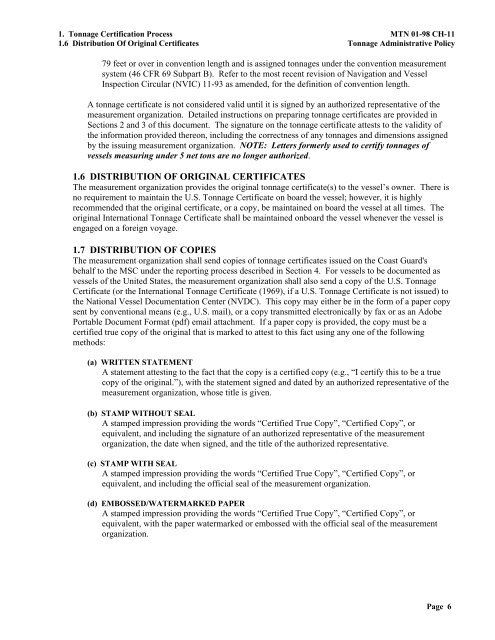Marine Safety Center Technical Note - U.S. Coast Guard
Marine Safety Center Technical Note - U.S. Coast Guard
Marine Safety Center Technical Note - U.S. Coast Guard
You also want an ePaper? Increase the reach of your titles
YUMPU automatically turns print PDFs into web optimized ePapers that Google loves.
1. Tonnage Certification Process MTN 01-98 CH-11<br />
1.6 Distribution Of Original Certificates Tonnage Administrative Policy<br />
79 feet or over in convention length and is assigned tonnages under the convention measurement<br />
system (46 CFR 69 Subpart B). Refer to the most recent revision of Navigation and Vessel<br />
Inspection Circular (NVIC) 11-93 as amended, for the definition of convention length.<br />
A tonnage certificate is not considered valid until it is signed by an authorized representative of the<br />
measurement organization. Detailed instructions on preparing tonnage certificates are provided in<br />
Sections 2 and 3 of this document. The signature on the tonnage certificate attests to the validity of<br />
the information provided thereon, including the correctness of any tonnages and dimensions assigned<br />
by the issuing measurement organization. NOTE: Letters formerly used to certify tonnages of<br />
vessels measuring under 5 net tons are no longer authorized.<br />
1.6 DISTRIBUTION OF ORIGINAL CERTIFICATES<br />
The measurement organization provides the original tonnage certificate(s) to the vessel’s owner. There is<br />
no requirement to maintain the U.S. Tonnage Certificate on board the vessel; however, it is highly<br />
recommended that the original certificate, or a copy, be maintained on board the vessel at all times. The<br />
original International Tonnage Certificate shall be maintained onboard the vessel whenever the vessel is<br />
engaged on a foreign voyage.<br />
1.7 DISTRIBUTION OF COPIES<br />
The measurement organization shall send copies of tonnage certificates issued on the <strong>Coast</strong> <strong>Guard</strong>'s<br />
behalf to the MSC under the reporting process described in Section 4. For vessels to be documented as<br />
vessels of the United States, the measurement organization shall also send a copy of the U.S. Tonnage<br />
Certificate (or the International Tonnage Certificate (1969), if a U.S. Tonnage Certificate is not issued) to<br />
the National Vessel Documentation <strong>Center</strong> (NVDC). This copy may either be in the form of a paper copy<br />
sent by conventional means (e.g., U.S. mail), or a copy transmitted electronically by fax or as an Adobe<br />
Portable Document Format (pdf) email attachment. If a paper copy is provided, the copy must be a<br />
certified true copy of the original that is marked to attest to this fact using any one of the following<br />
methods:<br />
(a) WRITTEN STATEMENT<br />
A statement attesting to the fact that the copy is a certified copy (e.g., “I certify this to be a true<br />
copy of the original.”), with the statement signed and dated by an authorized representative of the<br />
measurement organization, whose title is given.<br />
(b) STAMP WITHOUT SEAL<br />
A stamped impression providing the words “Certified True Copy”, “Certified Copy”, or<br />
equivalent, and including the signature of an authorized representative of the measurement<br />
organization, the date when signed, and the title of the authorized representative.<br />
(c) STAMP WITH SEAL<br />
A stamped impression providing the words “Certified True Copy”, “Certified Copy”, or<br />
equivalent, and including the official seal of the measurement organization.<br />
(d) EMBOSSED/WATERMARKED PAPER<br />
A stamped impression providing the words “Certified True Copy”, “Certified Copy”, or<br />
equivalent, with the paper watermarked or embossed with the official seal of the measurement<br />
organization.<br />
Page 6
















